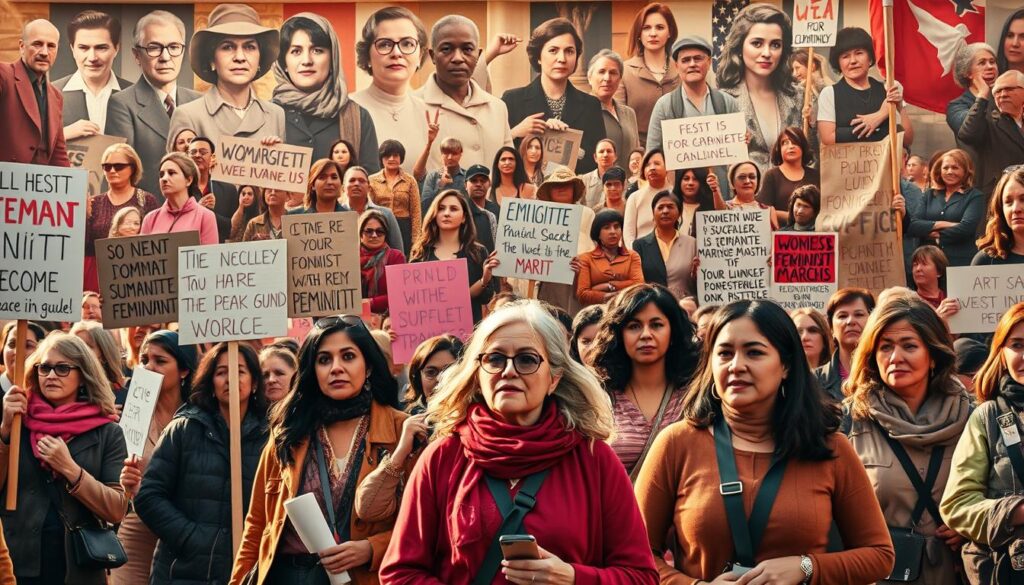Imagine a world where every girl grows up knowing her voice holds power. From classrooms to boardrooms, agency over life choices reshapes futures – not just for individuals, but entire nations. This transformation lies at the heart of advancing gender parity.
Global studies reveal startling connections. The FAO reports communities with educated females see 23% higher agricultural productivity, while UNDP data links economic independence to reduced child mortality rates. Leaders like Michelle Obama demonstrate this ripple effect through initiatives promoting girls’ education across 62 countries.
Three pillars drive lasting change: literacy, resource access, and leadership roles. When schools prioritize STEM for young girls, tech industries gain diverse perspectives. Microfinance programs in developing regions show how $1 invested in female entrepreneurs yields $7 for local economies.
Key Takeaways
- Education boosts community productivity by 23% (FAO)
- Economic independence reduces child mortality rates
- Female-led businesses reinvest 90% of earnings locally
- Gender-balanced leadership increases corporate profits by 21%
- STEM education for girls closes critical tech gaps
From rural villages to corporate America, shifting power dynamics create measurable progress. The next sections explore how policy reforms, mentorship programs, and data-driven strategies accelerate this global movement.
Defining what is women empowerment
How do societies shift from limiting traditions to creating equitable systems? The answer lies in structured frameworks that build self-determination and resource equity. According to the Center for Girls Foundation, true progress requires dismantling barriers across personal, economic, and political spheres.
Understanding the Concept and Key Principles
At its core, this movement focuses on three pillars: recognizing intrinsic value, expanding decision-making authority, and ensuring fair resource distribution. Rural awareness campaigns in India demonstrate this – when mothers gain financial literacy, household nutrition improves by 40%.
Kenya’s community-led programs showcase how leadership training transforms local governance. Women participating in these initiatives report 65% greater involvement in public budgeting decisions. Such changes ripple through education access and healthcare reforms.
The Role of Education, Rights, and Awareness
Schools teaching legal rights in Brazil reduced teen marriage rates by 30% within five years. Digital literacy workshops in Appalachia empowered 12,000 participants to launch small businesses. These efforts align with UN Sustainable Development Goal 5, which links economic participation to national GDP growth.
Supportive policies like paid parental leave in Sweden and microgrant systems in Ghana prove systemic changes create lasting impact. When girls see engineers and politicians who mirror their identities, ambition becomes attainable.
Historical and Global Perspectives on Women’s Empowerment
From suffragettes to modern activists, the journey toward gender parity has been a relentless pursuit. Milestones like New Zealand’s 1893 voting rights breakthrough ignited global reforms, while the 1979 UN Convention became a blueprint for legal equality. These efforts transformed how societies view leadership and opportunity.
Tracing Feminist and Women’s Rights Movements
The 1848 Seneca Falls Convention marked America’s first organized demand for voting rights and property ownership. British suffragettes led by Emmeline Pankhurst used civil disobedience to secure partial voting access in 1918. Canada’s 1929 Persons Case legally recognized females as qualified for Senate roles, rewriting constitutional definitions.

Post-WWII momentum saw 129 countries grant voting rights by 1945. Second-wave feminism in the 1960s tackled workplace discrimination and reproductive autonomy. Recent movements like #MeToo exposed systemic abuse, proving historical struggles remain relevant today.
Evolution of Gender Equality Across Countries
Nordic nations lead in political representation, with Iceland electing its first female president in 1980. Rwanda’s post-genocide constitution mandated 30% parliamentary seats for females, achieving 61% by 2023. Contrast this with Saudi Arabia’s 2015 voting rights expansion – a cultural shift in restrictive environments.
Global campaigns like HeForShe mobilized 2.4 million men as allies since 2014. Legal reforms in Argentina (2020 abortion rights) and India (2013 anti-harassment laws) show progress varies but persists. These changes reflect both grassroots activism and international policy alignment.
Economic Dimensions of Women’s Empowerment
Financial autonomy reshapes lives beyond individual households, creating ripple effects across entire economies. Modern economic systems present both opportunities and hurdles for those seeking equitable participation.
Neoliberal Impacts and Market Participation
Deregulation policies increased formal workforce access but intensified gender wage gaps. The World Bank reports women in developing nations earn 18% less than male counterparts despite equal qualifications. Welfare reforms like America’s TANF program reduced cash assistance durations, pushing many single mothers into unstable gig economy roles.
Microcredit and Resource Access for Economic Independence
Bangladesh’s Grameen Bank model shows small loans spark big changes – female-led businesses there achieve 68% repayment rates. Land ownership rights in Uganda boosted agricultural productivity by 15% when resource control shifted to female farmers. Yet UN data reveals 740 million lack basic financial services, limiting growth potential.
Balancing market demands with domestic care remains challenging. Studies show working mothers spend 4.1 hours daily on unpaid labor – triple the time fathers invest. Successful initiatives like Kenya’s mobile banking platforms demonstrate how tailored solutions bridge these gaps, increasing savings rates by 22%.
Political and Digital Empowerment of Women
Breaking barriers in politics and technology creates pathways for inclusive growth. When leadership roles and digital tools align, marginalized voices gain platforms to drive systemic change. Over 80 countries now use quotas to accelerate political representation, while grassroots activists leverage social media to demand accountability.
Policy Reforms and Political Participation
Rwanda’s 30% parliamentary quota transformed governance – female lawmakers now hold 61% of seats, the highest globally. This shift led to healthcare reforms and stricter gender-based violence laws. India’s Panchayati Raj system reserves 50% of local council seats, empowering 1.4 million female leaders to allocate community resources.

Digital Skills and Online Engagement for Social Change
Brazil’s “Meninas Digitais” program trained 80,000 in coding, enabling tech startups that address education gaps. UNDP reports digital literacy boosts civic participation by 37% in rural areas. Kenyan activists used Twitter campaigns to expose corruption in water projects, forcing 12 local officials to resign.
Organizations like WIPO invest in patent training for female inventors, bridging STEM gender gaps. When Tunisian activists livestreamed election irregularities, international observers pressured reforms. These efforts prove digital access and political will can reshape societies faster than traditional methods alone.
Community Initiatives and Educational Opportunities
Grassroots efforts spark transformative change where it matters most – neighborhood centers, vocational schools, and community workshops. Organizations like the Center for Girls Foundation prove targeted programs create measurable improvements in leadership and economic stability. Their scholarship initiatives have enabled 15,000 adolescents to complete secondary education since 2018.
Local Programs and Training for Female Empowerment
Vocational training bridges opportunity gaps in underserved regions. In Appalachia, digital marketing workshops helped artisans sell handmade goods online, boosting incomes by 40%. Nairobi’s craft cooperatives train members in quality control and export logistics, tripling product reach across East Africa.
Mentorship networks amplify these efforts. Detroit’s Women in Skilled Trades program pairs apprentices with experienced electricians and welders. Participants report 75% higher job placement rates compared to standard courses. Monthly community forums in rural Guatemala allow leaders to share agricultural innovations, improving crop yields for 8,000 families.
Partnerships between NGOs and governments scale impact. Bangladesh’s collaboration with BRAC established 200 tech hubs offering coding classes. Graduates founded 60 startups addressing healthcare access and literacy gaps. Such initiatives align with sustainable development goals, proving local action drives national progress.
Conclusion
Societies thrive when all members contribute equally to progress. Data from the FAO and UNDP confirms this: communities prioritizing education and resource access for girls see 23% higher productivity and reduced child mortality rates. Rwanda’s political reforms and Brazil’s digital literacy programs prove systemic change starts with equitable opportunities.
Three elements remain vital for lasting gender equality. Economic independence through microfinance initiatives boosts local economies. Political participation, as seen in Kenya’s activism, drives policy reforms. Digital skills training bridges tech gaps while amplifying marginalized voices.
Leaders must prioritize funding for STEM programs and leadership pipelines. Citizens can advocate for fair parental leave policies and support community mentorships. When nations invest in development strategies that value half their population, entire economies prosper.
This isn’t about charity – it’s smart growth. The WIPO reports female-led innovations increase patent diversity by 34%. Together, we can build futures where every girl shapes her destiny and strengthens her community. Progress waits for no one.


